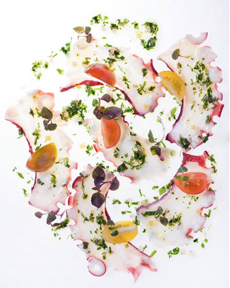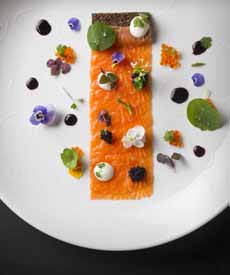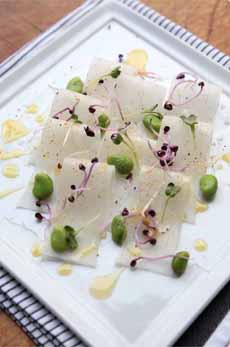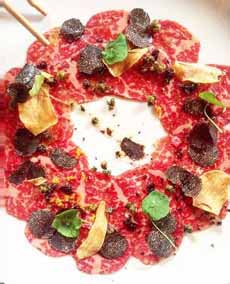|
Carpaccio (beef) and crudo (seafood) are easy to make, and present themselves as a sophisticated dish that took you a lot longer to prepare. If you eat sushi, sashimi, steak tartare and other raw preparations, it’s a dish you can easily make at home.
From the earliest times, fishermen have eaten their catch onboard, without cooking it.
Before man learned to make fire, some 350,000 years ago, the catch was de facto eaten raw.
The tradition continues today. Fishermen bring a bit of salt and/or citrus, and enjoy the rustic version of carpaccio, crudo, poke, or sashimi: brethren raw fish dishes.
While crudo has been eaten for millennia, carpaccio is a modern dish, created in Venice in 1963, at the time of an exhibition dedicated to Venetian painter Vittore Carpaccio (1465-1526).
> Here’s a list of raw fish dishes.
A recipe for a crudo of tuna or salmon (or other seafood) is below.
CARPACCIO VS. CRUDO & OTHER RAW FISH DISHES
Carpaccio is Italian for raw fillet of beef, not fish. Crudo is the term for raw fish or seafood. You will find fish “crudo” on restaurant menus, but that doesn’t make it correct. While raw fish consumption is ancient, beef carpaccio was based on the Piedmont speciality, carne cruda all’albese (raw beef Alba-style), created by Giuseppe Cipriani, founder of Harry’s Bar in Venice. Using fine Piedmontese beef (Piemontese in Italian), he originally prepared it for a countess whose doctors had recommended that she eat raw meat. At the time, there was a local exhibition of the 15th-century Venetian painter Vittore Carpaccio; hence the name of the dish.
Ceviche, seviche or sebiche, from South America, is a marinated raw fish dish that date to pre-Colombian times. Then, seafood was “cooked” (acid-cured) with a fruit called tumbo (Passiflora tarminina, a relative of passionfruit). The Incas cured fish in salt and fermented corn. The Spanish brought onions limes, which are essential to today’s ceviche.
Crudo is analogous to sashimi—plain raw fish, although the fish is cut differently.
Poke is a Hawaiian dish that recently has made its way from coast to coast. A mix of raw fish and vegetables are served as an appetizer or salad course. It is different from tiradito or ceviche in that the fish is cubed with a soy sauce and sesame oil dressing, and Hawaiian garnishes like roasted crushed candlenut and limu seaweed, along with chopped chiles. It is pronounced poe-KEH. Here’s more about it.
Sashimi is Japanese-style sliced raw fish, generally served with a bowl of plain, steamed rice (not sushi rice, which is prepared with vinegar and sugar). The word literally means “pierced body.” No one is certain of the origin, but it may have come from the former practice of sticking the tail and fin of the fish on the slices, to let it be known which fish one was eating.
Tataki is a fillet of fish that is lightly seared; just the surface is cooked, with the majority of the fish eaten in its raw state.
Tiradito is a more recent dish, fusing the concepts of ceviche and sashimi. Fish is sliced in pieces that are longer and thinner than sashimi. They are artfully arranged on a plate on top of a light sauce, and garnished (with cilantro, fresh corn kernels, thin slices of hot chile, etc.). The name derives from the Spanish verb tirar, which means to throw (i.e., throwing together raw fish with a sauce). Here’s a recipe.
Don’t worry if you can’t keep these straight: We saw a dish called carpaccio at New York City’s top seafood restaurant, which was clearly tiradito (with sauce and chile garnishes).
RECIPE: CRUDO OF TUNA, SALMON, OR OTHER SEAFOOD
Tailor this recipe to your preferences. For example, you can replace the conventional olive oil drizzle with flavored olive oil, add the Italian-style shavings of Parmigiano-Reggiano cheese, add balsamic vinegar, use a Dijon vinaigrette, etc.
You can add as much salad on top as you like…or none at all. If adding a mound of salad, dress it very lightly (we like lemon vinaigrette—half vinegar, half lemon [or lime] juice) before topping the fish.
Ingredients For 4 Servings
1 pound sushi-grade fish loin or steaks, sliced as desired
Quality extra-virgin olive oil
Sea salt, plus peppermill
Minced chives
2 cups baby greens, loosely packed: arugula, watercress or mesclun mix (more as desired)
Vinaogrette as desired
Garnishes: capers, microgreens, thinly-sliced hot chile and lemon wedges
Preparation
1. Combine vinegar and mustard in small bowl; whisk in 4 tablespoons olive oil. Season dressing to taste with sea salt and pepper. DO AHEAD: Can be made 1 day ahead. Cover; chill.
2. Place a sheet of plastic wrap on a damp work surface (the moisture prevents the plastic from slipping).
Arrange the tuna slices on the plastic as you would like them to be on the plate (this makes plating them easy). Cover with a second sheet of plastic wrap.
3. USING the flat side of a mallet, gently pound the fish slices until they are to your desired thinness. Do this in batches as necessary.
Refrigerate the fish in the plastic for at least 30 minutes, and up to 4 hours.
3. ASSEMBLE: Remove the top plastic sheet from each serving of fish and place a plate upside-down on top of the fish.
Invert the fish onto the plate and peel off the remaining plastic. Drizzle with olive oil, then sprinkle with a bit of sea salt, chives and pepper.
Toss watercress and 2 tablespoons dressing in medium bowl; season to taste with sea salt and pepper.
4. MOUND the salad greens on top and serve.
WOULD YOU RATHER HAVE BEEF CARPACCIO?
Take a look at:
Filet Mignon Carpaccio
“Stonehenge” Beef Carpaccio (fancifully decorated)
|
|

[1] Bluefin tuna crudo (photo © Caviar Russe | NYC).

[2] Octopus crudo (photo © Katsuya | Los Angeles).

[3] Salmon crudo (photo © Mihoko’s 21 Grams | NYC).

[4] Squid crudo (photo © Njam! TV).

[5] You can top carpaccio or crudo with as much salad as you like (photo © Cooking Channel TAV).

[6] Wagyu carpaccio, simply dressed with truffles and garlic potato chips (photo © Catch NYC).
|





